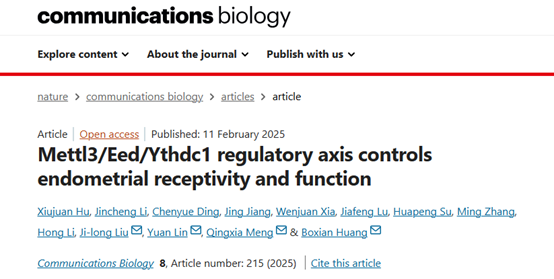
Endometrial receptivity--the uterus's ability to accept embryos--is a key determinant of successful pregnancy. Recurrent implantation failure (RIF), a major challenge in assisted reproductive technologies, significantly compromises reproductive outcomes for affected individuals. Although impaired decidualization of the endometrium is known to be a major contributor to RIF, the precise epigenetic mechanisms involved remain poorly understood.
The study found that the expression of the key RNA m6A methyltransferase METTL3 and the overall m6A methylation level were significantly reduced in the endometrial tissues of RIF patients and corresponding mouse models. Using conditional gene knockout mouse and cellular models, the researchers demonstrated that endometrium-specific deletion of Mettl3 leads to abnormal endometrial structure, impaired function, and significantly reduced fertility in mice. Mechanistically, METTL3 catalyzes m6A methylation to facilitate the recruitment and regulation of EED, a core component of the PRC2 histone modification complex. Loss of METTL3 results in decreased m6A modification on EED transcripts, thereby weakening the recognition and binding of the m6A “reader” YTHDC1 to EED. This, in turn, leads to a reduction in H3K27me3 levels and alters chromatin accessibility, ultimately disrupting the expression of key genes essential for endometrial receptivity, such as LIF, HOXA10, and HAND2.
This study is the first to elucidate the critical role of the METTL3–EED–YTHDC1 regulatory axis in controlling endometrial receptivity, identifying its dysfunction as an important molecular basis of RIF. The findings not only deepen our understanding of the “cross-talk” between RNA epigenetic modifications and histone modifications during reproduction but also highlights the METTL3/EED axis as a promising target for improving endometrial receptivity and treating RIF.

Professor Boxian Huang and Professor Qingxia Meng from Gusu College, Professor Yuan Lin from the National Key Laboratory of Reproductive Medicine and Offspring Health, and Professor Jilong Liu from South China Agricultural University are the co-corresponding authors of the paper. Doctoral students Xiujuan Hu and Jing Jiang from Gusu College, along with Assistant Researchers Jincheng Li, Chenyue Ding, and Wenjuan Xia, are the co-first authors. This research was supported by the National Natural Science Foundation of China, the National Key R&D Program, the Suzhou Clinical Key Disease Project, the Gusu Health Talent Program of Suzhou, and the Jiangsu Provincial Key Discipline (Laboratory) of Medicine.
Link to the original article:
https://www.nature.com/articles/s42003-025-07667-y
(Drafted by the Department of Science and Technology, Affiliated Suzhou Hospital,NMU; Reviewed by Wang Changjun; Translation revised by Zhang Bei)



